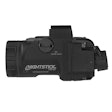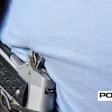Editor's Note: View our photo gallery of Ruger's SR-556.
It was with a great degree of fanfare that Ruger introduced its new SR-556 rifle at last year's National Rifle Association show in Phoenix. The announcement ended years of speculation that Ruger was indeed working on an AR-style rifle, and the SR-556 quickly became the buzz of the show, stirring the interests of black gun fanciers.
While the newest Ruger long gun possesses many typical AR features it also has a Ruger-designed piston drive system. The patent-pending, chrome plated two-stage piston system provides a cleaner, cooler running, and more reliable operation than any standard AR gas impingement system can deliver. After a cursory examination of display rifles at the NRA show I placed an order for my test gun.
Stone Cold
Several months later I received my test and evaluation sample and was very pleased with what I found when I opened the box. In addition to the piston drive upper, the SR-556 possesses a 16-inch, chrome-lined, hammer-forged barrel, a free-floating railed handguard, folding front and rear sights, and other high-end features and accessories.
Ruger not only used components of top quality on this rifle, it obviously has done quite a bit of market research to understand what features savvy shooters desire and incorporated those into the SR-556's design. In fact, I found the rifle to possess many features that a savvy shooter would want for a patrol carbine.
The SR-556 lower receiver is like just about any other AR lower that you'll find on the market, but it has some nice touches. Machined from an aluminum forging, the lower receiver is outfitted with a six-position M4-style collapsing stock and a rubber Hogue pistol grip.
My test sample possesses a standard single-stage trigger that breaks at a very clean 6.25 pounds. Of course, like any other rifle built to mil standards, the fire control group can be replaced with any of the many available two-stage target triggers if desired. Likewise the buttstock and pistol grip can also be switched out.
What sets the SR-556 apart from any other AR on the market is its piston drive upper. Its design is simple and effective and it works as advertised.
When the rifle is fired, gas is bled from the barrel into the gas regulator where it hits the small diameter of the piston. As it moves rearward, the larger diameter of the piston imparts a very smooth impact on the transfer rod, which in turn provides a smooth powerstroke to the bolt carrier, starting the unlocking, extracting, ejecting, and feed sequence. Excess gas is vented out the bottom of the gas block. Unlike a standard gas impingement system, no gas is vented back into the receiver keeping the bolt carrier and receiver incredibly clean and cool even after voluminous firing. Ruger's Website has a video of a shooter firing a 30-round magazine as quickly as he could pull the trigger and then removing the bolt carrier and remarking that it is stone cold.
Adjusting the Gas
The SR-556 has an adjustable gas regulator which controls the amount of gas that is used to cycle the piston and bolt carrier. The "0" position does not allow any gas to cycle the action, which makes the rifle act as a manually operated single shot. Rounds can be extracted, ejected, and a fresh round chambered by pulling back on the charging handle and releasing it. Typically this setting would be used with a suppressor to eliminate any action sounds.
There are three other gas port settings labeled "1," "2" and "3," which vary in size with "1" being the smallest and "3" being the largest. Ruger advises using the smallest gas port setting that reliably cycles the action with the particular ammunition that you're using.
Weapon life may be shortened if you use a larger gas port opening than is necessary. Most commercial ammunition will cycle reliably on setting "2," which is an ideal starting point when first shooting the SR-556. Ruger recommends looking at the ejection pattern of your casings. If they are ejecting forward, at a 2 o'clock position, you are using too much gas. On an ideal setting, you will see the brass ejected just to the right of the gun. Without enough gas they will eject toward the rear, if they eject at all.
To adjust the regulator, the knurled portion can be turned by hand or a cartridge or cleaning rod can be inserted in the hole for increased leverage. It is important that the regulator detent locks solidly, thus ensuring that the gas port is properly aligned.
The Transfer Key
Ruger follows the standard AR-15 bolt carrier pattern closely on the SR-556 with a couple of exceptions. While the length of the bolt carrier is the same it does not have a bolted on gas key. Instead Ruger wisely chose to machine the protrusion that the energy transfer rod impacts into the bolt carrier body. Called a Transfer Key in Ruger nomenclature, it is an integral part of the bolt carrier body. I know that there are a couple piston drive conversion kits that include a bolt-on unit to replace the carrier's gas key and those seem to be the weak point of those conversions.
Bolt carrier tilt is also a concern for those using piston drive weapons. In simple terms the piston strikes the bolt carrier above its center of mass and that can cause the bolt carrier to tip at the rear end, which can cause accelerated wear on the lower receiver and receiver extension (buffer tube).
To combat this problem, Ruger increased the rear diameter of the bolt carrier to more snugly fit the receiver extension (increased the diameter by .046 inches for the last .70 inches of the bolt carrier). I checked my SR-556 and found that indeed the buffer tube did show signs of polishing where the bolt carrier had rubbed it on the bottom behind the buffer retaining pin though it had not changed anything dimensionally. Ruger advises that this is normal but also recommends watching to ensure that the buffer retaining pin is not affected or causes wear on the bottom of the bolt carrier.
I noticed on my bolt carrier group that the bolt moved freely, which is unusual for a brand new AR rifle. I felt stupid when I disassembled the bolt because it had no gas rings. Standard direct gas impingement guns use the rings as a gas seal. There's no need for a gas seal on a piston drive gun-hence no rings and free movement of the bolt.
Rails and Optics
Ruger uses a 16-inch, hammer-forged barrel on the SR-556. The barrel is chrome lined and features a 1:9-inch twist. The end of the barrel terminates in a bird cage-style flash hider. Unlike the A2-style flash hider this one is not closed on the bottom and could potentially cause problems for the shooter firing from the prone position over loose dirt or sand. Fortunately, Ruger uses a standard thread, ½-28, and the flash hider is removable. Those wanting to use a more suppressor friendly flash hider will easily be able to switch out this part.
The SR-556's free-floating rail system is manufactured by Troy Industries and is approximately 10 inches long and the bridge between the rifle's upper receiver flat top and the handguards top rail is in perfect alignment and perfect for those that like to mount their optics far forward. Troy also manufactures the folding front and rear sights that are included on the SR-556. A sight adjustment tool is included with the rifle to dial in windage and elevation.
During the field portion of my evaluation I used Insight Technologies' new Mini Red Dot Sight (MRDS), a lightweight ruggedized reflex sight that mounts to any MIL-STD 1913 rail. Available with both 3.5 MOA-which I tested-or 7.0 MOA dot sizes, the sights also possess MOA positive click windage and elevation adjustments.
Weighing just .85 ounces, the extreme light weight of the sight makes it a natural for tactical use. Its top loading battery compartment ensures no change of windage during a battery change. The MRDS uses a single 1632 battery that Insight claims will last up to a year in the auto-mode. The MRDS features an auto adjusting dot intensity but also offers the operator a manual dot intensity adjustment with four brightness settings.
Designed to meet demanding military durability specifications, the MRDS lens is made from lightweight, impact resistant polymer with an anti-reflective coating. Its rugged housing is also molded from advanced polymers to save weight yet increase its operational durability.
Iron sights can co-witness though the MRDS sight. Its lightweight, extreme ruggedness, and long runtime make this sight the perfect complement for those who need an unobtrusive electronic sighting aid to help make the Ruger SR-556 an all light fighting weapon.
I did all of my accuracy testing at 100 yards using a Trijicon 3-9X AccuPoint set on its highest power magnification. One thing that I noticed is that the majority of my groups were nice and round without evidence of vertical or horizontal stringing.
Impressive Accuracy
I was particularly impressed with the Black Hills 50-grain V-Max bullets that produced the nicest five-shot group measuring just .53 inches. While this particular load may not be my first selection as a tactical load, I always include it in the accuracy portion of any evaluation of a 5.56mm rifle with a 1:9-inch twist barrel, as it is consistently the most accurate load. My goal here is not to see what possesses the best terminal performance but rather test the weapon's mechanical accuracy.
In this case, the Ruger matches up to anything I have ever tested. I own a 24-inch heavy barreled 5.56mm rifle set up as a precision gun and this particular group, fired from Ruger's carbine, comes close to matching anything that I have recorded with that particular rifle. I am impressed.
I brought along another AR-15, 16-inch carbine, standard gas impingement, built by another manufacturer when I did some field shooting with the Ruger. I'd fire a couple double-taps on a steel target with one and then switch to the other. I was unable to feel any real difference between the gas impingement gun and the Ruger piston drive rifle.
Final Thoughts
I'm impressed with the new Ruger SR-556. It is accurate and reliable and possesses many features that make it compatible with police use. The Ruger designed piston drive system works well and does provide the shooter with a cleaner, cooler weapon.
While at first glance you may think the suggested retail price of $1,995 seems high, I urge you to do some research and compare the SR-556 to other piston-drive rifles with the same refinements. You'll see that it is a bargain in its class.
Mike Detty is an NRA-certified rifle, pistol, and shotgun instructor. A certified rangemaster and competition shooter, Detty served as an officer in the U.S. Marine Corps and holds a degree in criminal justice from the University of Arizona.
FOR MORE INFORMATION:

















